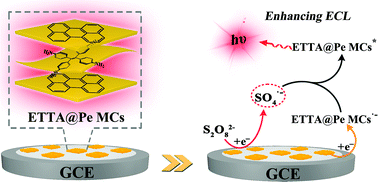Tetrakis(4-aminophenyl) ethene-doped perylene microcrystals with strong electrochemiluminescence for biosensing applications
Abstract
Perylene and its derivatives, as classical organic polycyclic aromatic hydrocarbon (PAH) ECL materials, have attracted extensive attention due to their excellent photoelectric activity and good structural controllability. As is well-known, the molecular structure of perylene is composed of five coplanar aromatic rings. There are intense π–π stacking interactions between perylene molecules, which lead to their aggregation and poor solubility in aqueous media. Unfortunately, this aggregation can weaken or even quench the emission intensity of perylene owing to the aggregation-caused quenching (ACQ) effect, finally limiting the analytical application of perylene in biological detection. In this work, perylene composite microcrystals (ETTA@Pe MCs) doped with non-planar molecular tetrakis(4-aminophenyl)ethene were synthesized in the aqueous phase by a surfactant-assisted self-assembly method. During this process, the intense π–π stacking interactions between perylene monomers were suppressed by doping. As a result, the ETTA@Pe MCs exhibited a significantly enhanced ECL signal as compared to that of perylene microcrystals (Pe MCs) in the presence of S2O82− as a co-reactant. Moreover, the ETTA@Pe MCs were utilized as a novel electrochemiluminescent (ECL) luminophores to fabricate a sensitive ECL biosensor for the quantitative analysis of dopamine (DA), which displayed a favorable linear response from 1 to 100 μmol L−1 with a detection limit of 0.96 nmol L−1.



 Please wait while we load your content...
Please wait while we load your content...